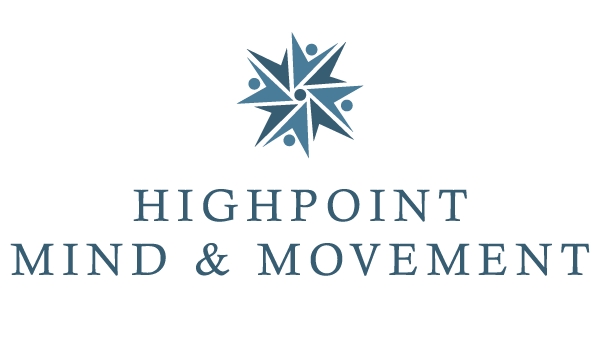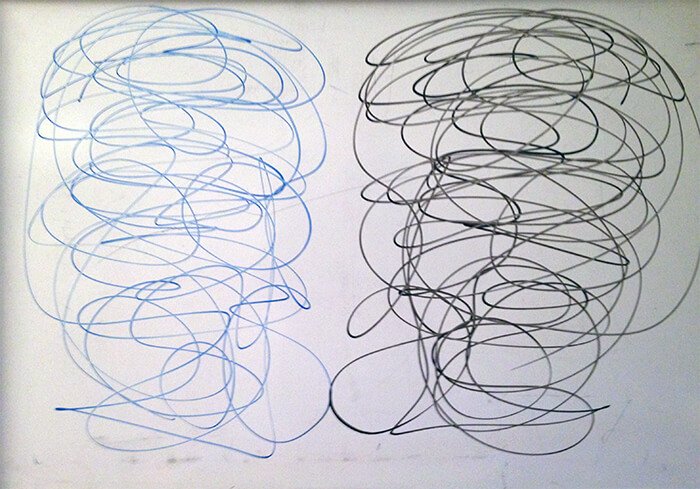Activating the Brain through Doodling
The Double Doodle as squares.
Let me introduce you to a wonderfully simple activity that activates your brain, develops hand-eye coordination, and strengthens your fine motor movements: The Double Doodle*. This is a movement activity of choice with my clients who have difficulty with writing and reading, but it also promotes creativity, clearer thinking, and has an added benefit of being quite calming.
The Double Doodle is a fun, playful brain exercise that develops bilateral integration of our brains by using both of our hands together over the midfield of the body in order to establish direction and orientation of our body in space. It relaxes the eyes, stimulates the neural connections used for crossing the midline, and develops visual discrimination and spatial awareness. In addition, it strengthens coordination between the left and right sides of the brain and body, establishing an awareness of the center of the body versus the sides.
Difficulties in reading and writing are related to reversals, directionality, and sequencing—skills which emerge directly from an awareness of sided-ness (the right and left sides of the body). Activity across the midfield develops and strengthens those “sub-skills” necessary to read and write by promoting bilateral integration of the eyes and hands in relation to the central midline of the body.
Many children and adults with learning difficulties have a hard time with motor and perceptual skills, so they cannot easily process what they see, which makes reading and writing a challenge. If you’ve noticed problems using both hands together, feel clumsy, or struggle with fine-motor skills such as handwriting, the core of the issue may lie an inability to cross your midline.
The Double Doodle as squiggles.
The Double Doodle encourages us to use both hands together and to cross the midline. These “bi-manual” movements develop coordination between the right and left hemispheres, coordinate our eyes and hands, widen our peripheral vision, and promote a firm sense of where we are in space – allowing for the development of the fine and gross motor movements that underlie learning.
In order to write, you need to not only coordinate your eyes and hands together but to also coordinate using the eyes in unison (tracking) as they move across the paper, easily shifting from left to right of the midline. Many of the foundational motor and visual skills that support reading and writing can be strengthened through the playful Double Doodle.
Try It! The Double Doodle
The Double Doodle involves drawing or “doodling" with a marker in each hand at the same time. The drawing may be of simple shapes, faces, letters, or any type of random design.
We begin with large motor movements followed by smaller and smaller movements in both the vertical plane, such as on a white board, and in the horizontal plane, as on a table. Each step in the process exercises the brain in slightly different ways.
Step One
Stand in front of a white board or tape paper to the wall to draw a “Double Doodle” pattern with large movements. The pattern can be random circles, squiggles, or a picture.
Hold a marker in each hand and place the tips side by side at the center of the white board. If using a blank wall, simply use your fingers rather than a marker.
Begin drawing with both hands at the same time to create a symmetrical, mirror image pattern – when the left hand goes to the left, the right hand goes to the right. And when one hand comes toward the center, the other also comes toward the center.
Practice holding your eyes at the center of the paper as you draw, noticing what you are able to see out of the corners of your eyes. This widens your visual span – your peripheral vision – helping to orient you in space.
Step Two
Once you have experienced The Double Doodle on the white board or wall, sit at a table with a piece of paper placed squarely in front of you. Double Doodles on a table develop coordinated movement in the horizontal plane. This is helpful for writing and other academic tasks.
Begin with a piece of paper larger than 8 ½” by 11” to encourage large movements. It may be helpful to tape the paper to the table to allow greater freedom of movement.
As you did on the white board, hold a marker (or crayon, pen, or pencil) in each hand and place the tips side by side at the center of the paper. Begin drawing with both hands at the same time to create your mirrored images. Remember to focus your eyes in the center. Notice the difference you feel when working in the horizontal plane on the table vs. the vertical plane on the white board or wall.
Step Three
Place an 8 ½” by 11” piece of paper on the table and repeat the exercise with smaller movements. You can even practice this exercise holding a pencil (or pen) as if you are going to write or print something: place your wrists on the paper and using only the movements of your fingers draw your Double Doodles – very small indeed!
That’s it – enjoy this fun and creative exercise, and the freedom of working with both sides of your brain!
* The Double Doodle is a movement trademarked by Brain Gym® International
The views expressed in this article belong solely to S. Christina Boyd based on 30 years of clinical experience as a movement therapist. Please reach out if you would like further reading or have any questions.




